Tag: Professional Development
Social media tools and platforms – Reflection on INF506 Module 3

OLJ Task: Social news sites – My Musings
Recent events have caused a major cultural shift in how we view ‘news’ and the media responsible for ‘reporting’ the ‘news.’ Yet, it is not actually all that recent. I myself (born in the 1970’s) can remember turning off the television or radio when the news came on, because it was just a report of everything that went bad in the world on that day, not to mention the fact that the glossiness and gleaming smiles of the presenters did not match my reality and provided me no social capital. My sister in law prefers Instagram to Facebook for exactly that reason: she finds Facebook brings her down, where Instagram less so. Many of my colleagues refuse to engage in a professional Facebook page because they claim ‘we don’t use it for that.’ This concept of being lost in the quagmire of negative ‘news’ (or the ‘negativity bias’ of humans) is not new as seen in publications such as this BBC news article (Stafford, 2014).
In any discussion around society (online or otherwise) it is important to recognise that human societal narratives are a result of their environment, not the cause. While face-to-face interactions have had a series of ‘rules’ and guidelines for civility, online interactions by comparison are merely at their infancy stage and so too are the devices which regulate them.
When looking at the following online news media sites: reddit, Digg, Newsvine, Hacker News, and Nuzzel I look hesitantly. I suppose I am old school? I like my news to be newsworthy? I dislike having to sift through advertising (often made to look like news) – its exhausting! Reddit pages that I follow or that they’ve selected for me based on what I’ve put in as my ‘interests’ tell me ‘lurkers are welcome.’ Digg has a better layout, more professional…Newsvine is run by NBC which I know to be a local network out to make a profit. HackerNews – no thanks, hacking is illegal and I don’t want to be a party to it even remotely. Apparently ‘top influencers’ use Nuzzel…is this what we’ve come to? Aspiring to be a ‘top influencer?’
UPDATE: For more academic reflections on social news media, please see my (extra) blog post: This Just In – Reflecting on the 2021 American Insurrection.
Social media tools and platforms – Reflection on INF506 Module 3
First of all, how cool is the website “Internet Live Stats?” My mind boggles at the amount of background work required to obtain this information and I wonder at its reliability…? But, it certainly offers a clear view at how daunting it would be to keep up with all of those platforms in a small company!
- Continuing on from my previous blog post, individual contexts (eg. schools) need to identify the platforms, websites, blogs and social media that would best engage their users or prospective users and develop a digital (learning) environment (DLE) framework. To paraphrase Stoddart, Chan & Liu (2016, p.143):
“(While) an excellently considered and employed facilitation framework in no way guarantees a successful outcome… a non-existent framework or poorly facilitated project will certainly limit the chances of a successful project.”
2. In order to determine which platforms to use or how to use them in your context, consider the most populated social media platforms, who is using them (eg. according to Komljenovic (2018) more high-income earners might use LinkedIn, XING, ResearchGate or Academia.edu) and how often they are using them. As of October, 2020, Statista have identified the following social media platforms as the most popular, based on ‘active users’:

3. While digital environments have the capacity to improve our lives, we need to plan for maintaining a safe, professional and healthy work-life balance on social media and online overall. Specifically, in terms of social media, we need to be mindful of possible negative impacts for ourselves as professionals as well as for our users, particularly with regards to physical health, mental health, life satisfaction and body mass index (Shakya & Christakis, 2017). Shakya & Christakis (2017) recommend we plan how we will attempt to exponentially increase face-to-face interactions in order to counteract the negative impact of online interactions, and to maintain a policy of quality social media interaction rather than quantity of social media interaction.  (NOTE: I have also discussed in previous blog posts how, as teacher librarians, we need to work to assist our colleagues and students to manage the information overload issues of ‘filter failure’ and ‘filter bubble.’)
(NOTE: I have also discussed in previous blog posts how, as teacher librarians, we need to work to assist our colleagues and students to manage the information overload issues of ‘filter failure’ and ‘filter bubble.’)
4. I like the idea of using a ‘web log’ a.k.a. blog or wiki (using something like GoogleSites) as a library hub, helping teachers and students with information literacy and other relevant topics, as discussed by Maxwell (2019), and would seek to include this in the website of my future school / library context(s). I could also then share my blog posts or other library information via social media. Alfonzo (2019, p.33) suggests that libraries could use social media for communication and knowledge sharing, particularly reaching members of the community who might not know about the information sources otherwise.
5. I also feel that student blogging is a great idea, having done it for myself for two years as part of this degree, I am so glad, looking back that I’ve maintained my learning and have a way of reminding myself or others about key information science issues and learning. Maxwell (2019) suggests that student blogging, when monitored and done safely and effectively, can improve student literacy skills, global connections, sharing perspectives and links for families to view their children’s progress. I also like the idea of student wikis using GoogleSites, suggested as offering better understanding of the writing process for students (Stoddart, Chan & Liu, 2016).
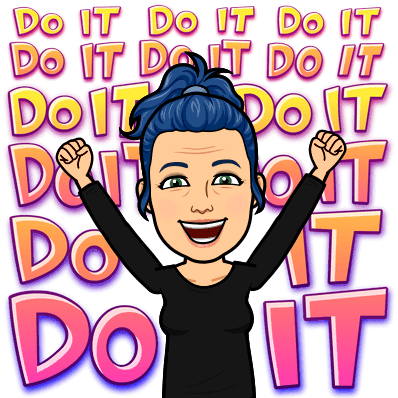
[I also like the idea of having a staff wiki. Currently, staff communicate via Sentral but have their own teaching programs and classroom strategies. These would be much better coordinated by a wiki or maybe GoogleSites?]
6. Promoting and advocating the library blog (&/or wiki) and the library on the context’s selected social media and intra-net platforms (i.e. using ‘micro blogs‘ / tweets) is a whole new concept for me. [Personally, I dislike Twitter, and indeed, the whole concept of word limits – if I’m honest! 280 characters or less? No thanks! I prefer the motto ‘why use 1 word when 20 will do!’] However, I like the idea of Mentionapp as an analytic tool for hashtags (although I had to set up a professional twitter account to use it and that turned out to be a bit of a hassle). I can also see the benefit of having live updates via a Twitter feed in times of hardship, such as the COVID-19 pandemic, as proven by Alajmi & Albudaiwi (2020). I am just not sure if I want to be the one responsible for it… Alfonzo (2019, p.35) recommends these things to ensure ‘search engine optimisation’ (SEO) and that is to use a business profile, use the same @handle across all accounts and link the accounts wherever possible (eg. Instagram links to Facebook), have an engaging profile picture (and for situations where teachers don’t want to use their own pictures they can use a Bitmoji), using the whole library name (in my case, ‘Teachers Who Know Me’ as I don’t work in a library yet) as the account names, @symbols and #hashtags, having a library mission statement and contact details in the description or bio, add categories and story highlights wherever the application allows, and use the free analytics some social media networks offer.
7. Roadblocks and concerns abound! Not only am I concerned about the physical, financial and well-being cyber safety of young or naive social media users, I am also concerned about which members of the community social media does NOT reach or whose views are being privileged (based on the user demographics). I have concerns as well about the increased workload (and budgetary expense) of maintaining a digital learning environment – including social media platforms. Furthermore, the fears and issues around change leadership that may arise when introducing innovation in a workplace (which may or may not have a community of practice work culture). I myself am reluctant to use Twitter with any level of skill or benefit to the context and I consider myself fairly tech savvy (so, I can only imagine how someone less tech savvy might feel at being forced to use these platforms) and training and development will surely be required if the platforms are to be of any success… Thus, I read Vanscoy, Hicks & Cavanagh (2018) with the hopes that they would offer some insight into how to manage these roadblocks.
References
(2019). Linkedin, platforming labour, and the new employability mandate for universities. Globalisation, Societies and Education. 17:1, 28-43. doi: 10.1080/14767724.2018.1500275
Maxwell, L. (2019). A librarian’s journey in blogging. Library Technology Reports, 55(5), 21-24.
Shakya, H.B., Christakis, N.A. (2017). Association of Facebook use with compromised well-being: a longitudinal study. American Journal of Epidemiology. 185(3). 203–211. doi: https://doi-org.ezproxy.csu.edu.au/10.1093/aje/kww189
Statista (2020). Global social networks ranked by number of users 2020. https://www.statista.com/statistics/272014/global-social-networks-ranked-by-number-of-users/
(2016). Enhancing successful outcomes of wiki-based collaborative writing: a state-of-the-art review of facilitation frameworks. Interactive Learning Environments. 24:1, 142-157. doi: 10.1080/10494820.2013.825810
Vanscoy, A., Hicks, D., & Cavanagh, M. (2018). Understanding public libraries’ conversations: Promises and challenges of microblogging data. Paper presented at the Proceedings of the Annual Conference of CAIS/Actes du congrès annuel de l’ACSI.
Best practice for leading and supporting digital citizenship
(Reflecting on my learning in ETL523 Modules 4, 5 & 6)
“Digital leaders understand that we must put real-world tools in the hands of students and allow them to create artefacts of learning that demonstrate conceptual mastery. This is an important pedagogical shift as it focuses on enhancing essential skill sets—communication, collaboration, creativity, media literacy, global connectedness, critical thinking, and problem solving – that society demands….Leaders need to be the catalysts for change…..Digital leadership begins with identifying obstacles to change and specific solutions to overcome them in order to transform schools in the digital age” (Sheninger, 2017).
Notably, in terms of creating a productive digital learning environment, Sheninger (2017) identifies ‘7 pillars for digital leadership in education’ as: communication, public relations, branding, student engagement/learning, professional growth/development, re-envisioning learning spaces and environments, and opportunity.
Rather than avoid global connections and social media, and rather than limit our students (forcing them to go ‘underground’ with a secret world of digital environments of their own making) we need need to learn how to embrace it safely and productively as global digital citizens (Ohler, 2011). We also need our school principals and supervisors to help promote a community of practice and positive learning environments by being “willing to listen, delegate, distribute, empower, and step out of the way of the learning” (Lindsay, 2016, p.110).
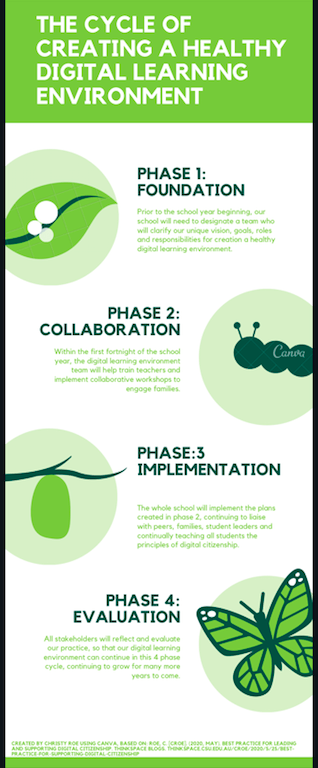
Utilising the readings for modules 4, 5 and 6, as well as a few of my own, following the 6 month multi-phase structure suggested by Chen & Orth (2013), Cofino (2012) and Common Sense Media (n.d.) which begins prior to the start of the school year, we can complete the following 4 phases:
-
Prior to the school year beginning, school contexts need to begin phase 1 by clarifying our unique vision, goals, roles and responsibilities:
- First. form a strong team of information and digital technology leaders (Chen & Orth, 2013; Common Sense Media, n.d.). (See my previous 9 blog posts on creating a school Community of Practice or the evaluation of practice via the 3 blog posts on Quality Teaching Framework/Rounds and also this video on Teacherpreneurs from the Centre for Teaching Quality for motivation!)
- Create and deliver an environmental scan utilising this template for a ‘Situational Analysis’ by Christy Roe (based on suggestions from) the resources provided by Hague & Payton (2010), and/or Pashiardis (1996), particularly as shown in the hexagon images below:
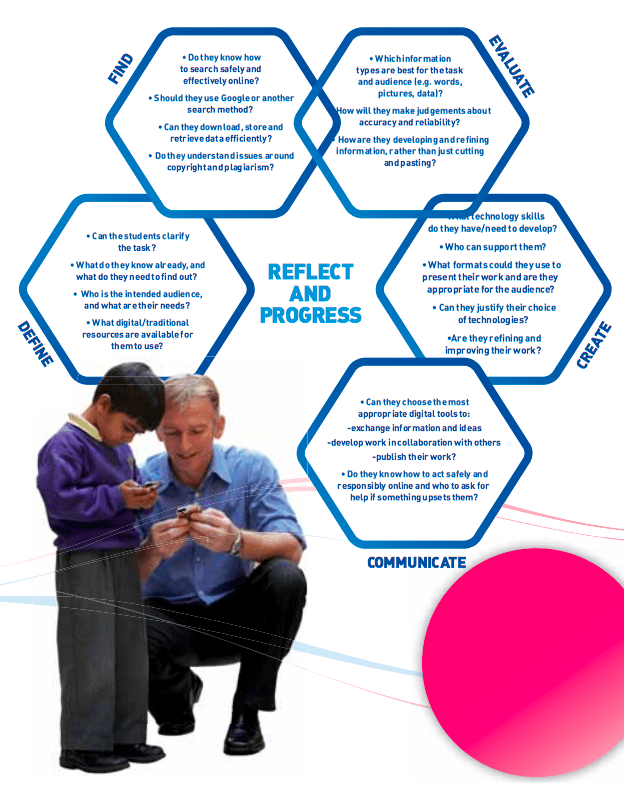
Digital Literacy Planning Tool ‘Reflect & Progress’ image by Hague & Payton, 2010, p.47 - Implement a technology audit (such as this one created by Christy Roe) and/or bullying survey (such as this one created by the University of South Australia) (Chen & Orth, 2013).
- Facilitate the formulation of policies, procedures or guidelines such as an acceptable use policy (using a questionnaire such as this one created by Christy Roe) based on the policy created by the administration (such as those listed in the resources section below), including cohesive terminology that we will utilise as a school (Common Sense Media, n.d.), e.g. linking the Positive Behaviour for Learning Behaviour Matrix or Code of Student Conduct to the school’s “Acceptable use Policy (AUP), Responsible Use Guidelines (RUG), Acceptable Use Agreement (AUA), Internet Use Policy (IUP), Bring Your Own Device (BYOD), or Bring Your Own Technology (BYOT)” etc.
- Liaise with others in our personal learning networks (PLN) (Sheninger, 2017) to map the digital citizenship areas of the syllabus or curriculum documents (NESA / ACARA), find examples of a digital citizenship scope and sequence (such as this (2011) one by Mike Ribble), develop sample lessons or units of work, and accumulate appropriate resources (such as those provided in the resources section below)–made available to all stakeholders (Common Sense Media, n.d.).
- Allow teacher librarians (and the school leadership teams) to readily undertake the role of information leaders who ‘meet the students where they are,’ recognising that there may not only be gaps in terms of technology access, or information access, but there may also be an (intergenerational) gap between what some view as the purpose of technology – i.e. is the purpose of technology to assist in informing, socialising or varying degrees of both, and what is true for the individuals in each school or home context? (Levinson, 2010, p.11).
2. In phase 2, within the first fortnight of the school year, we must train teachers and engage families:
“Alignment between school and home with regards to digital citizenship and healthy digital usage is a hallmark of a 21st-century school. A community-wide understanding of the norms, rules of behaviour, rules of engagement, and common practices is necessary for all schools in order to raise an ethical, digital (and real-life) citizen. Without this key parental partnership, these conversations regarding digital citizenship will just become incoherent whispers in the minds of our students, overwhelmed by the louder voices of media, false information, and misunderstanding” (Chen & Orth, 2013).
- As per the circles image from Hague & Payton (2010) (as well as information from Sheninger (2017)), schools and families need to continually foster 21st century learning and digital literacy skills such as: creativity, (innovation), critical thinking, evaluation (and problem solving), cultural and social understanding, collaboration, effective communication, (global collectedness), the ability to find and select information, (media literacy), e-safety and technological functional skills.
- While at the same time, we must also utilise situations of technology misuse as learning opportunities (see the POISE image below) for the students as well as ourselves as adult digital citizens, setting appropriate boundaries, listening student voices, and continuously encouraging digital literacy and digital citizenship (Chen & Orth, 2013).
- Educators as professionals need to get onboard with 21st century learning and nurture safe, culturally aware, global citizenship and global connections for ourselves as well as for and with our students (Hilt, 2011);
- We must ensure that our digital citizenship curriculum not only protects our students in terms of safety, privacy, copyright, fair use or legality issues, but that it also promotes global cultural, gender, socio-economic status, religion, language and ability awareness and a global appreciation of difference (Hilt, 2011).
- Educators who have embraced the need for global digital citizenship and global connections, need to lead by example and have our own safe, culturally aware, positive and professional ‘brand’ or digital footprint, and we also need to help our students create and tailor their own safe, culturally aware and positive digital footprint ‘brand(s)’ (Neilson, 2012).
- The digital citizenship leadership team, or perhaps even the whole staff, need to hold regular meetings and face to face information and collaboration sessions with families to ensure that preferred means of communication are clarified, that families have input into the digital citizenship program and also so that families are given support in implementing policies, procedures and guidelines at home that suit their individual situation(s) (Chen & Orth, 2013; Levinson, 2010).
- Finally, the digital citizenship team need to develop a plan to help students move from digital citizenship to digital leadership by creating a technology peer mentorship or student technology leadership program (such as YesK12.org) (Oxley, 2012; TeachThought Staff, 2018).
3. In phase 3, we must implement our plans:
- Prior to students being given devices, we must workshop the digital citizenship expectations, policy, procedures and guidelines that we created in phase 1 & 2 (Cofino, 2012).
“The message is threefold: (1) helping children become good digital citizens must be an ongoing practice led by families and schools together; (2) having access to a range of technology and global connections through school creates a positive context in which to have these conversations; and (3) students will make mistakes, and it’s our collective responsibility to turn mistakes into learnable moments” (Chen & Orth, 2013).
-

Bitmoji Christy ‘Do it!’ Once students begin to utilise digital devices, we must implement the digital citizenship lessons or units of work that we created in phase 2, with a key focus on 21st century learning skills, boundaries, student voice, digital footprints and global connections.
- We must implement the peer mentorship program that we created in phase 2, including student voice in the consequences for unacceptable behaviours (such as the student court, implied by in the slideshow by Cofino, 2012).
- We must continually check in with families, using the resources and communication devices agreed upon in phase 2.
4. And finally, in phase 4, we will reflect and evaluate:
![Growth Coaching International (n.d.) Growth Framework [Image]](https://teacherswhoknowme.edublogs.org/files/2020/05/Growth-Coaching-International-n.d.-GROWTH-Framework-Image.jpeg)
List of resources for Teachers and Students:
Policies, procedures or guidelines:
- New South Wales Department of Education and Training’s Policies & procedures > Student use of digital devices and online services (implemented January 27, 2020)
- eSafety Commissioner Teacher Resources;
- State of Victoria (Department of Education & Training) – Consent, Acceptable use agreements and Online services (updated November 2018)
- Sample BYOT Policies http://www.teachthought.com/technology/11-sample-education-byot-policies-to-help-you-create-your-own/
- Sample BYOD Policies http://www.k12blueprint.com/byod
- ‘An overview of school AUP’ written by David Warlick (2008)
- New Zealand Ministry of Education – Digital technology: Safe and responsible use in schools (2015). See also Netsafe.
- Code of Conduct (formerly Digital Citizenship Policy) Garibaldi Secondary School (USA).
- Using digital technologies to support learning and teaching – Victorian State Government, Australia
- Edutopia How to create social media guidelines for your school
- Alberta Canada Social Media Policy for School Districts
Resources for digital citizenship lessons:
- In addition to those recommended in my team’s ETL523 Assessment 2 website, there are also:
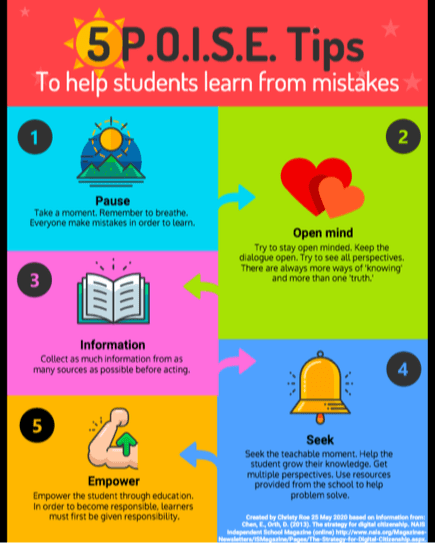
5 POISE Tips Infographic PDF by Christy Roe using information from Chen & Orth (2013) - 5 POISE Tips Infographic (shown here) by Christy Roe, based on information from Chen & Orth (2013) for use by both teachers and families
- Common Craft. (2011). Protecting reputations online. http://www.commoncraft.com/video/protecting-reputations-online.
- Common Sense Media. (2010, November 2). Our Connected Culture. http://youtu.be/L0XQj1anI-E
- eSafety Commissioner Cyberbullying resource
- Digital Life Student Intro Video by Common Sense Media, (2010),
- Overexposed
- Attention young professionals! What’s in your digital baggage?
- DontYouForgetAboutMe. (2007, August 11). Everyone – Think before you post (English). http://youtu.be/4w4_Hrwh2XI.
- ‘I Forgot My Phone’ (YouTube | 2:10 mins) | http://www.youtube.com/watch?v=OINa46HeWg8 CharstarleneTV. (2013, August 22). I forgot my phone. http://www.youtube.com/watch?v=OINa46HeWg8.
Examples of global citizenship programs:
- Global Citizen Diploma program
- Lindsay, J. (2009, March 7). Digiteens go global. http://www.slideshare.net/julielindsay/digiteens-go-global (The Digiteens program is no longer running but information is still available about how to implement it).
- Mirtschin, A. (2012, April 26). Hello little world skypers. http://murcha.wordpress.com/2012/04/26/hello-little-world-skypers-group/
- Morgan, L. (2012, March 19). Skype with an astronaut! http://www.frugalteacher.com/2012/03/skyping-with-astronaut.html
- Internet censorship in China [Tag]. New York Times. https://www.nytimes.com/search?query=internet%20censorship%20in%20china&sort=best
References and further reading
- Beam, C. (2011). Bootleg nation: How strict are Chinese copyright laws? Slate. http://www.slate.com/articles/news_and_politics/explainer/2009/10/bootleg_nation.html.
- Chen, E., Orth, D. (2013). The strategy for digital citizenship. NAIS Independent School Magazine (online) http://www.nais.org/Magazines-Newsletters/ISMagazine/Pages/The-Strategy-for-Digital-Citizenship.aspx.
- Cofino, K. (2012, March 24). Digital citizenship: The forgotten fundamental. http://www.slideshare.net/mscofino/digital-citizenship-the-forgotten-fundamental.
- Common Sense Media (n.d.). Lesson in action: Super digital citizen. http://www.commonsensemedia.org/videos/lesson-in-action-super-digital-citizen
- Growth Coaching International (n.d.) Growth Framework [Image] https://www.growthcoaching.com.au/about/growth-approach?country=au
- Hague, C. and Payton, S. (2010). Digital Literacy Across the Curriculum (Futurelab Handbook). Futurelab. https://www.nfer.ac.uk/publications/FUTL06/FUTL06_home.cfm
- Hilt, L. (2011, October 26). The Case for Cultivating Cultural Awareness. http://plpnetwork.com/2011/10/26/the-case-for-cultivating-cultural-awareness/
- James, C., & Jenkins, H. (2014). Disconnected: Youth, New Media, and the Ethics Gap. MIT Press.
- Levinson, M. (2010). From fear to Facebook: One school’s journey. International Society for Technology in Education.
- Lindsay, J. (2016). The global educator: Leveraging technology for collaborative learning and teaching. International Society for Technology in Education.
- Lindsay. J. (2016, July 19). How to encourage and model global citizenship in the classroom. Education Week http://blogs.edweek.org/edweek/global_learning/2016/07/how_to_encourage_and_model_global_citizenship_in_the_classroom.html
- Lindsay, J. (2014, March 7). Digital citizenship: A global perspective. http://www.slideshare.net/julielindsay/digital-citizenship-a-global-perspective-reduced-size-32020944
- Lindsay, J. (2015, January 8). Leadership for digital citizenship action. http://www.slideshare.net/julielindsay/leadership-for-digital-citizenship-action-acec-2015
- Michaelsen, A. (2013, October 10). Connected educators for connect learners #ce13. http://annmic.wordpress.com/2013/10/10/connected-educators-for-connect-learners-ce13/
- Mirtschin, A. (2012, January 18). Empowering digital citizenship action. http://murcha.wordpress.com/2012/01/18/empower-digital-citizenship-action/
- Mirtschin, A. (2015, November 4). Talk of the school! https://murcha.wordpress.com/2015/11/04/talk-of-the-school/
- Murray, T. (2013, January 7). 10 steps technology directors can take to stay relevant. http://smartblogs.com/education/2013/01/07/the-obsolete-technology-director-murray-thomas/.
- Nielsen, L. (2012, October 29). 4 things you need to know to help your students manage their online reputation by. http://theinnovativeeducator.blogspot.co.uk/2012/10/4-things-you-need-to-know-to-help-your.html.
- Ohler, J. (2011). Character education for the digital age. ASCD Educational Leadership. 68(5). http://www.ascd.org/publications/educational-leadership/feb11/vol68/num05/Character-Education-for-the-Digital-Age.aspx.
- Oxley, K. (2012, August 12). Developing a digital citizenship program. http://www.slideshare.net/cathryno/developing-a-digital-citizenship-program.
- Pashiardis, P. (1996). Environmental scanning in educational organizations: uses, approaches, sources and methodologies. International Journal of Educational Management, 10(3), 5-9.
- Ribble, M.(2011). Digital citizenship in schools. International Society for Technology in Education.
- Sheninger, E. (2017, August 29). 7 pillars of digital leadership in education. https://www.teachthought.com/the-future-of-learning/7-pillars-digital-leadership-education/
- TeachThought Staff (2018, November 18). Moving students from digital citizenship to digital leadership. https://www.teachthought.com/the-future-of-learning/moving-students-from-digital-citizenship-to-digital-leadership/
- Tiven, M. E., Fuchs, E., Bazari, A., & MacQuarrie, A. (2018). Evaluating global digital education: Student outcomes framework. New York, NY: Bloomberg Philanthropies and the Organisation for Economic Co-operation and Development.
Protected: ETL504 Assessment 2 Part B – Reflection
Professional Learning Transference: Why professional development doesn’t always result in improved outcomes
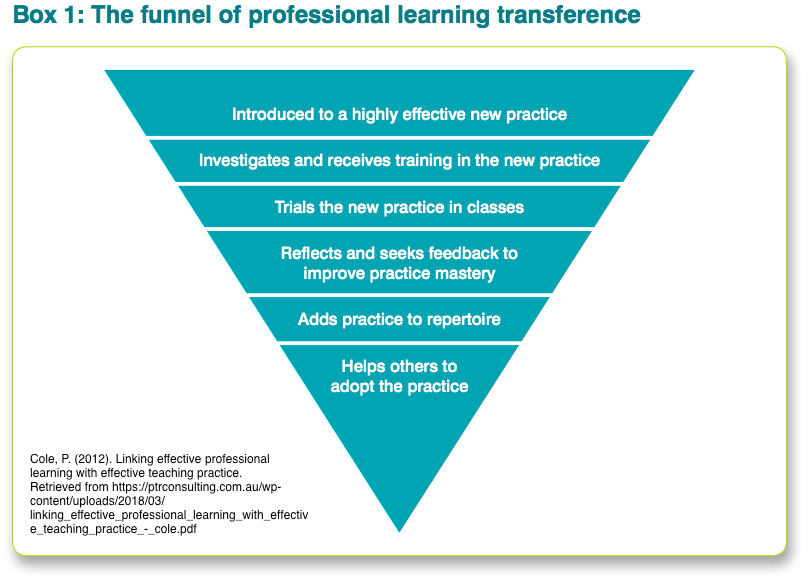
I was just saying to my husband the other day about how different this degree is to the training we receive as teachers. Even things that we are interested in, often get attended, our enthusiasm is strong as we walk through the doors of our school and then, mysteriously, we never seem to implement what we’ve learnt with any real vigour, or if we do it soon peters out, lost in the quagmire or superseded by the next training course we attend.
My husband is a Positive Behaviour for Learning (PB4L) Assistant Principal External Coach and the PB4L team in NSW are focussing on this exact phenomenon and implementing strategies demonstrated by Cole (2012), who explains very clearly why this occurs in the image (above) ‘The funnel of professional learning transference’ – Used here with permission from AITSL).
Most of us never make it to reflecting and/or seeking feedback to improve mastery, much less adding the practice to our repertoire and very very rarely helping others to adopt the practice.
This is where PB4L and QTR are both so beneficial! Out of all of the lessons I’ve modified based on training I’ve received, only one has stood out as something that I would fight vehemently to keep in my practice and that is the L3 shared reading lesson that I did in QTR. Following the successful lesson (where I received helpful feedback from three peers who had not attended the L3 training), all three wanted to learn how to implement the lesson (or series of lessons as it were).

I can see how this will help my assignment and help me create a community of practice in my library and at my future school(s)! I am totally capable of reflecting, helping others reflect, adding skills to my practice and helping others add them to theirs…Now to get it into my discussion paper somehow…
References
Cole, P. (2012). Linking effective professional learning with effective teaching practice. Retrieved from https://ptrconsulting.com.au/wp-content/uploads/2018/03/linking_effective_professional_learning_with_effective_teaching_practice_-_cole.pdf

![Hague, C., & Payton, S. (2010). Digital literacy across the curriculum [Handbook [Image]. pp. 19.](https://teacherswhoknowme.edublogs.org/files/2020/05/Hague-C.-Payton-S.-2010.-Digital-literacy-across-the-curriculum-Handbook-Image.-BECTA-FutureLab.-pp.-19.-National-Foundation-for-Educational-Research-httpswww.nfer_.ac_.uk-publicationsFUTL06FUTL06.pdf.png)